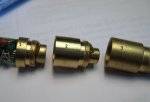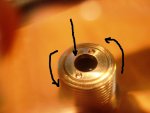@alx:
Your LPM readings are all screwed-up, which is likely part of what is confusing you on all of this!
With a Coherent Lasercheck optical meter,
it does not measure ONLY the wavelength you set it to - it measures ALL of the laser light hitting the sensor at that time! (regardless of wavelength!)
The purpose of the wavelength setting is
NOT to measure just that wavelength -
that meter cannot do that!
What it is for is to correct a problem associated with optical LPM's -
they are more sensitive to some wavelengths than others. The meter has to adjust the reading to compensate for this difference in sensitivity - the wavelength setting tells the meter how much it has to adjust the displayed power.
There is an easy way to verify this yourself - measure a laser that only puts-out one wavelength - a red laser. Then set the meter for 532, and measure the red laser again. Notice it is now giving you the wrong #! (probably higher). That is because the Lasercheck is less sensitive to green than to red, so it increases the displayed power to compensate for the difference in sensitivity!
Silicon sensors are often most sensitive around near-IR wavelengths, and drop-off on both sides. So if you are measuring 808nm, it has to reduce the displayed value (as it is most sensitive in that area), but if you are measuring green, it has to increase the displayed value (because it is less sensitive to green).
Assuming the power was the same each time, you can actually see the difference in sensitivity in those first 3 #'s you posted in #163 -
Lpm set at 532nm -> 41.5mw
Lpm set at 808nm ->3.2mw
Lpm set at 1064nm -> 12.2mw
So your Lasercheck's sensor is about 13x more sensitive to 808nm than to 532nm, and about 4x more sensitive to 808nm than to 1064nm!
That's why you're getting the wacky high measurements when you exposed the innards (releasing more IR radiation), and set the meter to compensate for green, instead of IR. It's reading the IR 13x higher power than it actually is.
The only valid readings would be with a filter, set to 532nm (and that's assuming your filter was a good one!)
And to measure the IR from inside -
Because in a DPSS laser, there are
TWO different kinds of IR (which your meter has
different sensitivities to), accurately measuring the IR from inside with an optical meter would require a way to filter-out one of the IR wavelengths, but let the other through unharmed. Otherwise, the only way with an optical meter is to physically pull the crystal set from the diode (
NOT recommended!), and then measure the 808 from the LD directly.
Second test: removed 3rd piece in my picture above.
Again, only valid # is 532nm with filter.
This piece is the collimating lens and aperture. Part of what it does is block outgoing light that is not straight, as well as the outermost part of the beam. Removing it will increase power a bit - for the same reason that increasing the aperture hole in my True 5 while trying to get it apart resulted in a wider (full Gaussian) beam coming through (including the part that the aperture was meant to block).
You will also get more power, because some of it is lost going through the lens (just like with an Aixiz).
But then your laser light is coming out of the beam expander unfocused - so you can't get a good beam that way!
OK, this is the part that freaked me out the most -
Third test: removed also 2nd piece too.
That is
EXTREMELY dangerous,

unless you are wearing IR-blocking goggles! That diode is open-can, and the die is exposed and visible (behind the crystals) with that 2nd piece removed -
which means you can have 808nm laser light coming directly from the diode!
You also have extraneous 1064nm IR laser light coming out of the crystal itself - and not just the reflective-coated end!
One of the purposes of that second piece is to cover-over and "block" much of that dangerous radiation from getting out! If you look inside the second piece, you will notice it is designed with a tiny hole in the center
right above the crystals, to allow light coming directly out of the end of the crystal to escape.
At this stage, we are loosing more than half of total power...
It is doing it's job - blocking much of the harmful IR radiation that is bouncing-around inside that container!
Note that you're not losing any
GREEN power

(with filter).
And by the way: looking in front of this piece, I can see with nacked eye the lens inside and COATINGS! YES, MAGENTA AND BLUE REFLECTIONS....so, no doubt, the 2nd piece is COATED and I think is acting as IR filter too...
No, it is not - otherwise, you wouldn't be getting those goofy high incorrect readings without a filter on your second tests!
That is likely an AR coating you are seeing - again, doing it's job, as the loss from the expander lens seems virtually non-existent!
IR diode inside seems to be 1W or more...
OVER 1W optical power at crystal output!!!
No, not physically possible!
First off, someone measured the forward voltage on one of these at 1.78V. At 570ma, that's total electric power into the diode of 1.0146W. In order to get 1W of 808nm out, would require a laser diode that was
over 98.5% efficient!
Unless you're module belonged to a Federation time traveler from the 24th century,
that's just not physically possible! 
To make matters even
MORE impossible, most of the IR is being used-up to generate the green, so even if you had 1W going into the crystals, you would still have much less than that coming-out the other end!
So unless you figured-out a way to tap into the vacuum energy of the universe and created a laser diode where you can put 1W of power in, and get 2W of IR laser out, then the readings you listed are a
complete physical impossibility!
Again, this is due to the bad meter readings - with the meter set to 532,
any 808 it gets exposed to is going to register 13x higher than actual, and any 1064 is going to measure about 3.4x higher than actual.
With the die of the diode exposed, I'm guessing those insanely high readings were likely mostly from 808nm.
Which also means you were exposing yourself to that!!! 
If you remove 2nd and 3rd piece... and put a match in front piece 1 (10cm away) it lit instantly...
Two reasons for that -
A) with that cover off, you've got a lot more dangerous IR combining with the green (so more total power); and
B) the beam coming out of the crystal is very tiny, so just like if you focused the beam to a small point, it is going to burn better!
In this case, the spot will become ugly at long distances
Only problem is, with a beam that tiny, the divergence sucks! That is part of what the expander lens (2nd piece) is for -
to expand the beam to a more reasonable size, so your beam divergence will be better.
If you remove ONLY 2nd piece, and join directly piece 1 with piece 3, we will have also the same situation
Again, same two reasons as above. If you want to use dangerous invisible IR as a burner, you would be better off just getting a True 5, potting it up, and ripping the crystals out - that would give you 250mw or more.
The reason the beam sucks is that
both pieces work together - the expander lens expands the beam (which will keep getting wider), and the collimator lens then lines-it back up to be a straight beam - just wider now! You need both pieces to make that work right!
I said no problem i will screw the lens in front of 3rd piece...Not lucky... seems to be glued...I attached a picture to this post... Did someone has success screwing it inside?
This is because if you look down inside the 3rd piece, you will see a piece of metal behind the lens that is holding it in place. (In the case of my high-power module, it is flat black, in the lower-power units, it is bare brass metal)
I hope you did not do any major damage to your eyesight!
Do not run it without 2nd piece, and definitely not with both pieces off and the diode exposed - at least not without some good IR goggles!
I saw that are few peoples here owning DX 100mw green modules. I saw that seoguy is driving diode at his 100mw module at 530mA but nowhere I saw how much is the output power?
I have been waiting
FOREVER for my goggles to arrive before I tried testing my 100mw, as my main optical sensor is a bit reflective.
FocalPrice is actually
worse than DX on shipping times!!!
Well, they finally arrived Wed -
broke! :cryyy: Even folded, the plastic frame still sticks-out over 2" thick - and they just tossed them into a regular envelope and mailed it - didn't even mark it as fragile! :yabbmad:
Anyway, gonna see if I can jury-rig them up so I can do some testing on my 100mw.

Also waiting to see how the 10mw modules I ordered turn-out - their comments to you about "unstable" has me a bit worried! :undecided:
How long 'til you get yours - have they left Hong Kong yet?






